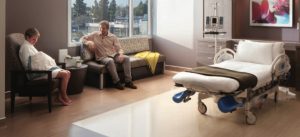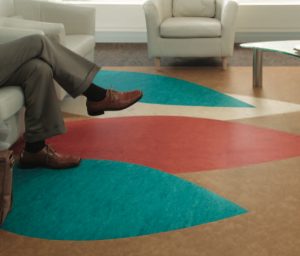Summer 2016
By Jana Pollack

Linoleum was invented in 1855 and has been a key flooring material ever since. But over the past 50 years the category has reinvented itself from a solely residential product to one that today is almost exclusively used in commercial spaces.
“I think if you were to go into a house built 50 years ago that still had its original floor covering, there’s a good chance you would find linoleum there,” said Joe Sumpman, commercial product manager at Armstrong. “However, in today’s residential environments you’re hardly seeing linoleum used at all. So we’ve seen a significant shift in linoleum’s use.”
There are many reasons for this, some having to do with evolving design trends and many relating to the benefits that linoleum can provide in a commercial space. Casey Johnson, Marmoleum business development manager, Forbo, said the product is attractive to commercial applications due to its sustainable characteristics. “Whether it’s lowering the impact you have on the environment or monitoring the health impact on the people within the building, there’s a strong health component and strong sustainability message that comes with linoleum.”
Linoleum is a natural product made predominantly from harvestable natural raw materials with low environmental impact. Linseed oil, made from flax, is a key raw material in linoleum. Once installed, the product is hygienic and anti-static. It is also naturally bacteriostatic.
Sumpman also made this point: “Oftentimes customers will ask me, ‘What’s the greenest product you have?’ Linoleum is a really good answer to that question. It’s made of all natural materials, so it doesn’t contain any PVC. It has a higher percentage of recycled content — 35% — than any other product we offer. It’s a very green product and gives a very organic feel visually.”
He also cited low maintenance costs as a reason for linoleum’s popularity in the commercial space. “We know that facilities — whether it’s a healthcare or an education application — are concerned with maintenance costs of their flooring,” Sumpman explained. “Linoleum has come a long way over the years as far as how it can be maintained; not having to use as much time and materials on maintenance is a key attribute that really makes it appealing for commercial spaces.”

Jeff Krejsa, senior vice president of marketing at Tarkett, also cited linoleum’s sustainable attributes but warned that this is a market that must continue to evolve. “As other resilient materials, such as vinyl, have been redeveloped and reformulated to provide greater sustainable options — think the move to non-phthalate construction, low emissions and recycled content— it is critical that linoleum evolve from a sustainable alternative to an option that provides enhanced aesthetics and performance.”
Krejsa explained that Tarkett has extended the design story by “completely revamping our color portfolio to coordinate with other resilient products, as well as introducing new patterns such as Lenz and Tonali.”
There is also a heavy focus on design at Armstrong. “When it comes to the design side of things, we’re always driving toward innovation,” Sumpman said. “For example, in our Lino Art line, we recently introduced a brand-new visual we call Rhythmics. It’s more of a striated visual and is much different than what you’re used to seeing in a typical linoleum visual. There will always be evolution on the design side, and we’re always going to try new things that we think will fit into commercial interior design trends.”
Forbo, too, will have a heavy focus on design in the coming years. “We’re on an incredible innovation curve with Marmoleum,” Johnson said. “We’re positioned to continue that growth by providing visuals, shapes and textures that the markets are looking for along with what Marmoleum is always known for: a great cost of ownership and extreme durability.”
Johnson believes linoleum has a very bright future. “The great thing about the product is it has always provided what the market requires. I think the investments we’re making in the product will be evident. The awesome thing about linoleum — the first resilient floor ever invented — is that it’s just as relevant today. That’s a good testament for having a sustainable business plan.”